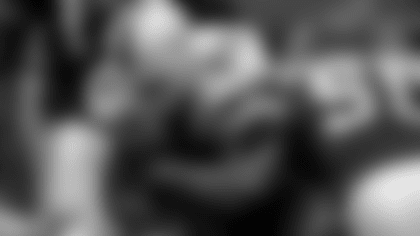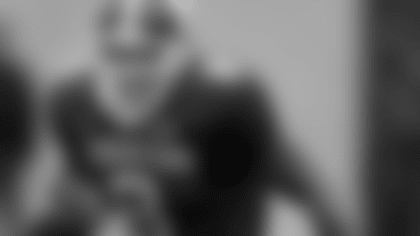Since Bill Belichick arrived as the Patriots head coach before the 2000 season, his defensive system has received a great deal of attention. He brought terms like "two-gap" and "3-4" into the everyday vernacular of Patriots fans all over New England.
Perhaps the most important pieces within Belichick's system are also the most unheralded: the defensive linemen. Belichick enjoyed tremendous success with his schemes in New York with both the Giants and Jets, as well as the Cleveland Browns. In all three places, his stalwarts up front were largely anonymous, hard-working players who were instrumental in the defense's success.
Players like Leonard Marshall, George Martin and Jim Burt with the Giants, Cleveland's Michael Dean Perry and Rob Burnett, and Jason Ferguson and Rick Lyle with the Jets all were solid if unspectacular starters who were vital to the defense. Defensive linemen in Belichick's system all have similar job descriptions: occupy blockers, keep them away from the linebackers and allow their teammates to gain the praise by making tackles.
With that in mind, Belichick's decisions to allow nose tackle Chad Eaton to walk away in free agency and to release Henry Thomas were met with raised eyebrows among many Patriots fans. Eaton and Thomas, while not in the spectacular, Pro Bowl mold, provided the team with the no-nonsense, run-stopping abilities that are imperative for that inglorious position.
But that's life in today's salary cap-driven NFL, where a host of new terms like "dead money," "signing bonus" and "contract restructuring" are as important as any technical football phrase even the most innovative coach could dream up.
So what's left in New England are a bunch of guys on the defensive line who for the most part fit the bill of Belichick's past players. Bobby Hamilton was signed as a free agent just before the start of training camp last year and is now entrenched as the starter at defensive end. Veteran Anthony Pleasant, who filled his role capably in both Cleveland and with the Jets under Belichick, is penciled in at the other end. Willie McGinest, the highest profile player of the bunch, will be entrusted with the most responsibility as the crash end.
But the biggest concern up front is the need to fill the obvious hole left by Eaton and Thomas at nose tackle. Among the players currently on the roster, only Garrett Johnson, with two starts last season, has any appreciable experience at the position.
"If we could add depth to any position on the roster that we felt like would upgrade us we would do it," Belichick said last month when asked about the need for improvement in the middle. While that's certainly true, it's also fair to say he would be more eager to find a nose tackle than say a quarterback or center.
The importance of the nose tackle position for the Patriots cannot be understated. Last season, New England held several quality running backs, including Warrick Dunn, Curtis Martin, Edgerrin James and Robert Smith, below the 100-yard mark during the early part of the season. When Eaton went down with a knee injury in a Week Six win over Indianapolis, things changed dramatically.
Without their anchor in the middle, the Patriots defense allowed back-to-back 100-plus-yard performances to Martin and James in losses at home to the Jets and at Indianapolis. The 164 rushing yards put up by the Jets was the second highest total (only the 178 allowed in a blizzard at Buffalo was higher) the team allowed all season.
Although the Patriots rushing defense tailed off a bit as the second half wore on, Martin and James remained the lone individuals to top the 100-yard mark against New England. Now the team must deal with life without Eaton plugging the middle full time.
"Any scheme you play, all the defensive linemen are vital," defensive line coach Randy Melvin said. "Garrett got some playing time last year and was tested so it's not like he's never been out there before and doesn't understand. I'm from the school that these are the guys who are here and these are the guys we've played with. We're going to get better with them and they're going to get better and that's our job."
The lack of experienced depth up front led Belichick and his chief personnel man, Scott Pioli, to point their fingers at a young defensive tackle from Georgia named Richard Seymour when their turn came at No. 6 in April's draft. Seymour is a versatile player who worked both inside and outside in college and Belichick and Melvin intend to work him at both spots until they decide how he can best suit their needs.
One plus for Seymour is the presence of Pleasant. Melvin described the 12-year veteran as "a student of the system" and he believes Seymour will benefit greatly from his tutelage.
"[Seymour's] a guy with a lot of athletic ability," Melvin said. "If not, we wouldn't have taken him. The beauty of it is I think he has the ability to be an inside or outside player. With that, the more he can do, the more value he can have and the more he can help the team. When it all shakes out, if he's the better man inside or the better man outside, that's where he's going to play."
Belichick stressed that Seymour would eventually be asked to focus more of his efforts on one spot or the other. But he also added that the ultimate decision "could be a reflection on him or it may be a reflection of what our needs are on the defensive line."
In other words, he could wind up inside stopping the run even if he's better suited as an outside pass rusher, or vice versa. That's a clear indication of the lack of depth. Another was the addition of former Seattle defensive tackle Riddick Parker. Despite starting every game for the Seahawks, who were last in the NFL in total defense and 28th against the run, Parker was allowed to walk and Seattle instead signed Eaton and veteran defensive tackle John Randle as free agents to bolster their sagging unit.
"What we have is a lot of competition going on," Melvin said. "We still have a lot of younger guys like Dave Nugent, Reggie Grimes and Jace Sayler battling for time. Riddick Parker is also here and he played tackle and some nose in Seattle. In their scheme, they would just slide their line and did some stuff that we do in our package, so he should adjust quickly."
Despite the questions in the middle, the key up front remains McGinest. After an 11-sack season in 1995 and a Pro Bowl trip in 1996, McGinest has been beset with injuries and hasn't been the impact player he's needed to be for most of the past four years.
As a result, the pass rush, which McGinest is largely responsible for, has suffered. After recording 25 sacks in his first three years, McGinest has just 20.5 since. Due in part to the lack of pressure, the Patriots problems on third down defense last season were perhaps the team's biggest concern heading into 2001.
"A healthy Willie McGinest is a playmaking type guy," Melvin said. "He had some bumps and bruises and some legitimate things he had to deal with last year. You expect him to make plays. If he's out there, he's got to get it done, no excuses. As a coach you can appreciate that he's a tough guy who's going to get out there and give you his all even if he maybe isn't at 100 percent.
"In a team concept, we've got to be able to get pressure to help the back seven. At the same time, they've got to be able to cover to help us so pointing blame at anybody is not unfair, but at the same time we've got to shoulder part of it. That's an area we're going to continue working on. These guys read what's being printed and they're going to work to improve, too."
In Belichick's system, which can vary between 3-4 and 4-3 sets, the defensive linemen are rarely going to emerge as dominant figures. Aside from McGinest, none of the current group has Pro Bowl potential. But what can be expected is solid, physical play against the run, and occasional pressure on the quarterback.
Most of the players have a year of experience playing the two-gap style that is so important in this scheme and should improve as a result. How much improvement made among those up front could go a long way in determining the defense's success.
















